Features -- Ji'an -- 18 August 2017
Ji'an is a medium-sized metropolitan area in Jiangxi Province, China. Far East Mobility's work on TOD is carried out in cooperation with BRT Planning International, LLC.
TOD challenges in China
Transit-Oriented Development (TOD) in China is a matter of grave concern to the world. The problem of climate change is most critically dependent on what happens in the next few decades in the energy and transportation sectors in China. While certainly China’s energy sector, heavily dependent on carbon-intensive coal, remains the greatest single threat to the global climate, its transportation sector remains a close second. While in recent years China has been making impressive strides to reduce its reliance on coal-fired power plants and replace these with renewable and less carbon intensive energy sources, on the transportation side, the outlook is far grimmer. China, which used to be a country of bicycles and tree-lined streets, in January 2016 reached 172 million cars, and is now the largest passenger vehicle market in the world. This is more than triple the number of cars registered in China in 2007. With car ownership of only around one in three households and 310 million licensed car drivers, there is plenty of room for this figure to grow. While the transport sector in China accounts for only about 10% of its total CO2-e emissions, emissions in the transport sector are projected to rise by 3.5% per year.
Much of this motorization rate is being encouraged by outmoded planning and building regulations.
In the meantime, bus-based transit is failing to keep up. The focus in many cities, including Ji'an, has been on converting the bus fleet to electric buses rather than on improving bus frequency and service, and this is reflected in stagnant or declining mode shares. (In Ji'an, while the fleet has been converted nearly wholly to electric buses, the overall city bus fleet has not increased signficantly since 2012.) In the short term, in small cities such as Ji'an, people are relying initially on electric bikes, and later on cars.
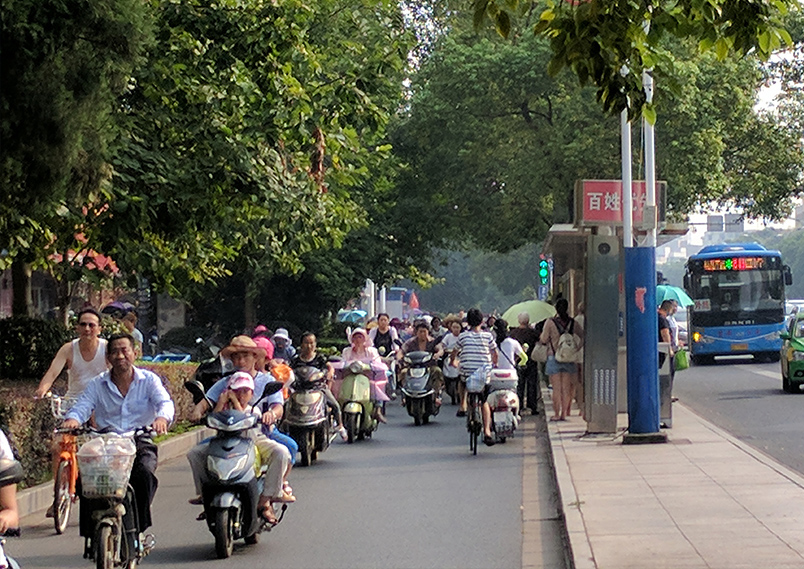 E-bikes pass a bus stop in Jinggangshan Avenue, Ji'an. With an unreliable bus service, most residents rely on cars and e-bikes for non-walking trips.
E-bikes pass a bus stop in Jinggangshan Avenue, Ji'an. With an unreliable bus service, most residents rely on cars and e-bikes for non-walking trips.
While in some parts of China, most notably Beijing and the other thriving east coast cities, historic levels of traffic congestion are indeed emerging and are constraining traffic growth, it is nonetheless astonishing the degree to which Chinese cities have been able to expand their road networks to keep pace with motorization. Therefore, while worsening traffic congestion may put some brakes on motorization in China, it is not as much of a check as is typical.
Much of this motorization rate is being encouraged by outmoded planning and building regulations. To give one example, most planning and zoning codes in China require the developers of residential buildings to include somewhere between 0.5 and 1 parking space for each new residential unit. That means China is building cities designed to handle about 0.5 to 1 car per household. This is not the only element that is dysfunctional from the point of view of encouraging transit use, cycling, and walking. Most of China’s planning and zoning regulations follow the textbook modernist aproach of separating not only noxious land uses from each other but also separating buildings from the surrounding streets by elevating them and setting them back from the property line. While this certainly had its benefits in the early 20th century, since that time most of the noxious elements of the urban street have been resolved through other means. While the separation of noxious industrial land uses continues to be a good practice, many land uses are considered compatible with each other, such as residences and offices, offices and retail, and retail and residences. The need to separate these functions is far less clear, and separating them has tended to add needless distance to people’s everyday life, distances that invariably induce the wealthy and middle classes to embrace the private automobile when it becomes an economic possibility.
Setback requirements make it impossible to maintain a continuous active street, and often the setbacks become reservoirs of unsightly and damaging vehicular parking.
While zoning codes which rigidly separate even compatible land uses are considered outmoded in almost all of Europe and in a growing number of US cities, they are still the dominant paradigm in China. In China, however, the outmoded nature of these regulations is having a particularly damaging long term effect because China is currently undergoing the world's largest ever housing construction boom.
Other elements of current Chinese zoning codes that are a hold-overs from 1960s era planning thought are the provisions on building set-backs that are aimed at ensuring that both the street and the rooms inside buildings have access to a reasonable amount of sunlight. While this remains a reasonable aim, the most progressive cities set performance standards for minimum hours of sunlight and allow developers more flexibility in determining how to meet the standard. Most cities also balance the needs of maintaining access to sunlight with the need to maintain an active streetfront and a continuous street façade. In China, setback requirements make it impossible to maintain a continuous active street, and often the setbacks become reservoirs of unsightly and damaging vehicular parking despite the fact that there is often unoccupied vehicle parking inside the building. (Setbacks refer to the space between the edge of the public walkway and the building facade. Older areas have no setbacks and provide a continuous facade and more attractive urban environment.)
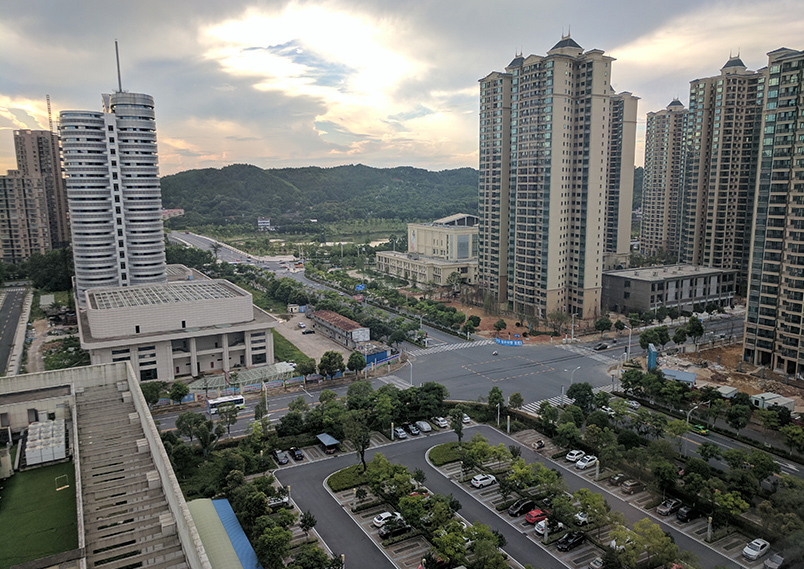 The view of a new administrative district from the Ji'an Municipal Government building illustrates many of the problems mentioned above, including gated single-use developments with large setbacks, discontinuous streetfronts, car parking yards between buildings and streets (with excellent landscaping underlining the priority given to car users), large pedestrian- and bike-impermeable blocks, lack of any bus priority measures, and a generally unattractive environment for transit, walking and cycling.
The view of a new administrative district from the Ji'an Municipal Government building illustrates many of the problems mentioned above, including gated single-use developments with large setbacks, discontinuous streetfronts, car parking yards between buildings and streets (with excellent landscaping underlining the priority given to car users), large pedestrian- and bike-impermeable blocks, lack of any bus priority measures, and a generally unattractive environment for transit, walking and cycling.
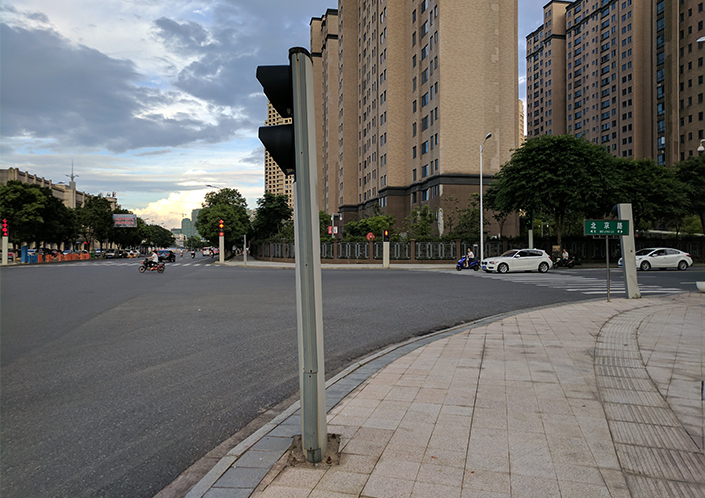 A street level view in the same new administrative district area, showing gated single-use developments, wide intersections with large turning radii for vehicles, and an overall highly unattractive pedestrian environment.
A street level view in the same new administrative district area, showing gated single-use developments, wide intersections with large turning radii for vehicles, and an overall highly unattractive pedestrian environment.
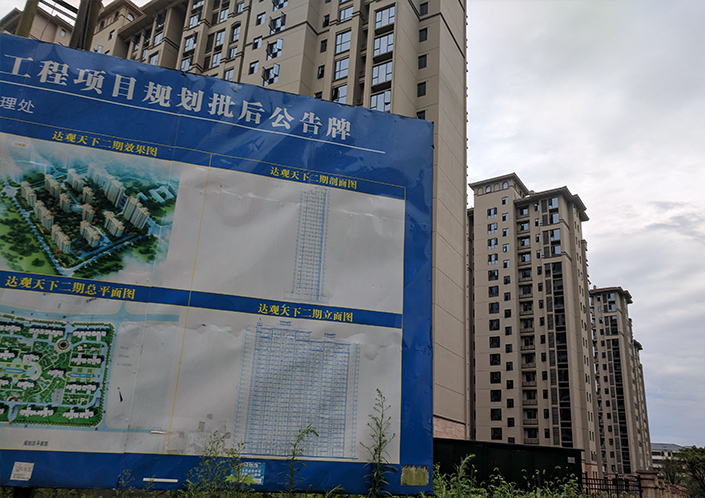 Gated single use development under construction in the northern Jizhou area of Ji'an.
Gated single use development under construction in the northern Jizhou area of Ji'an.
 Large building setbacks required to comply with the Jiangxi planning code result in discontinuous streetfronts and are often used for car parking, blocking and damaging walkways and making walking unattractive even for short trips.
Large building setbacks required to comply with the Jiangxi planning code result in discontinuous streetfronts and are often used for car parking, blocking and damaging walkways and making walking unattractive even for short trips.
 Even when not used for car parking, the large setbacks and single uses required under the zoning codes result in long sections of 'dead' streetfront. Shown here is a section of the proposed future BRT corridor, Jinggangshan Avenue.
Even when not used for car parking, the large setbacks and single uses required under the zoning codes result in long sections of 'dead' streetfront. Shown here is a section of the proposed future BRT corridor, Jinggangshan Avenue.
Therefore, changing China’s outmoded zoning and planning codes now is imperative. While it is too late to influence the millions of units of new housing that have already been built or have already been given approval to move forward, it is still important to update China’s zoning and planning regulations so that the millions of units of unoccupied residences can be retrofitted in ways more compatible with more sustainable modes of travel and a higher quality of public space.
From the perspective of sustainable transportation, experts already have a clear idea of what planning and zoning guidance is the most likely to lead to sustainable travel patterns and more livable cities, though these vary by country and city.
BRT and TOD in Ji'an
Together with BRT Planning International and with the support of the Rockefeller Brothers Fund, Far East Mobility is building on earlier work on TOD in BRT corridors in Guangzhou, Lanzhou and Yichang, to develop a BRT and urban development corridor plan in Ji'an, a city of around half a million inhabitants in Jiangxi Province. (When combined with the nearby urban areas of Ji'an County and Jishui, the population is about one million.)
Far East Mobility won an international bid to provide planning, design and supervision services for the BRT implementation in Ji'an, which is being funded by an Asian Development Bank loan. This work started in February 2017 and is ongoing. All of the key areas of urban transport and urban development intersect in the Ji'an project, including transit service and accessibility, BRT, TOD, parking (on-street and off-street), pedestrian and bicycle facility improvements, urban design and public space issues, city centre revitalization, planning and design of greenways, planning and design of new areas, design of new roads, and the size, use and management of setbacks. Ji'an has the potential to be a model city for hundreds of similarly sized metropolitan areas around China.
All of the key areas of urban transport and urban development intersect in the Ji'an project.
Within China, Ji'an is most well-known for its proximity to the nearby Jinggangshan Mountains, where Mao Zedong formed the Red Army together with key early Communist Party figures in the late 1920s. Though proud of its revolutionary heritage, Ji'an wants to move beyond an association with warfare, and in addition to revolutionary fervour to be known for modern and advanced urban development. To achieve this goal, Ji'an needs to make major changes to current planning approaches.
Current trends are not encouraging, with rapid growth in the private car fleet and correspondingly rapid declines in the use of e-bike and bicycles. The public transport mode share has been flat over the last five years. Private vehicle fleet growth exceeded 20% in every year between 2011 and 2016, and the registered private vehicles more than quadrupled between 2010 and 2016. These trends are clearly unsustainable.
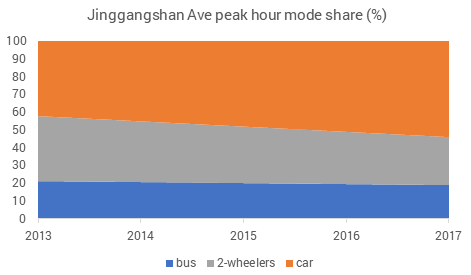 Mode share trends for non-walking trips in Jinggangshan Avenue, based on peak hour data from three locations in 2013, and ten locations in 2017. With rapidly increasing car mode share, the trend is unsustainable.
Mode share trends for non-walking trips in Jinggangshan Avenue, based on peak hour data from three locations in 2013, and ten locations in 2017. With rapidly increasing car mode share, the trend is unsustainable.
Source: traffic counts from ADB report in 2013, and vehicle and occupancy counts from Far East Mobility in 2017.
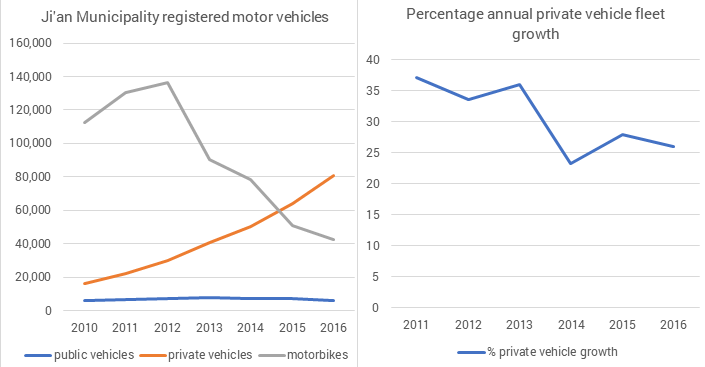 Ji’an municipal area registered vehicle fleet, and private vehicle fleet annual growth. The municipal area includes Jizhou, Qingyuan, and Ji’an County, the three main urban areas of Ji'an with a combined population of around 1 million inhabitants.
Ji’an municipal area registered vehicle fleet, and private vehicle fleet annual growth. The municipal area includes Jizhou, Qingyuan, and Ji’an County, the three main urban areas of Ji'an with a combined population of around 1 million inhabitants.
Source: Ji'an Municipal and Jiangxi Provincial Statistical Yearbook, with traffic police data processed and analysed by Far East Mobility.
Ji'an's planning and zoning regulations
Although the wider Ji'an area has a population of four million, the population of the built-up areas of Ji'an, Ji'an County and Jishui is around one million. Ji’an does not have its own Planning and Zoning Guidelines and as such, it follows the Jiangxi Province City Planning and Zoning Guidelines, currently from 2014. When comparing these guidelines to other municipal planning and zoning guidelines in China, it is very similar though somewhat less detailed than cities like Shanghai and Shenzhen, which have more comprehensive guidelines. The guidelines allow for minor variances within Jiangxi’s municipalities to accommodate local circumstances.
The Jiangxi Province City Planning and Zoning Guidelines will be discussed in detail in following articles.
Houses as savings, and ramifications for TOD in Ji'an
Many homes in China and especially in lower tier cities are not so much a place to live as a place to deposit one’s savings. Real interest rates in banks are very low for ordinary savers, and financial markets are underdeveloped and out of the reach of average people. Anecdotal observations suggest that even the average taxi driver in Ji'an owns one or two apartments, one in the central area to live in and one, usually sitting unoccupied in a new development area outside the urban core, for their son or daughter when they marry. Speculators also buy up large quantities of new apartments.
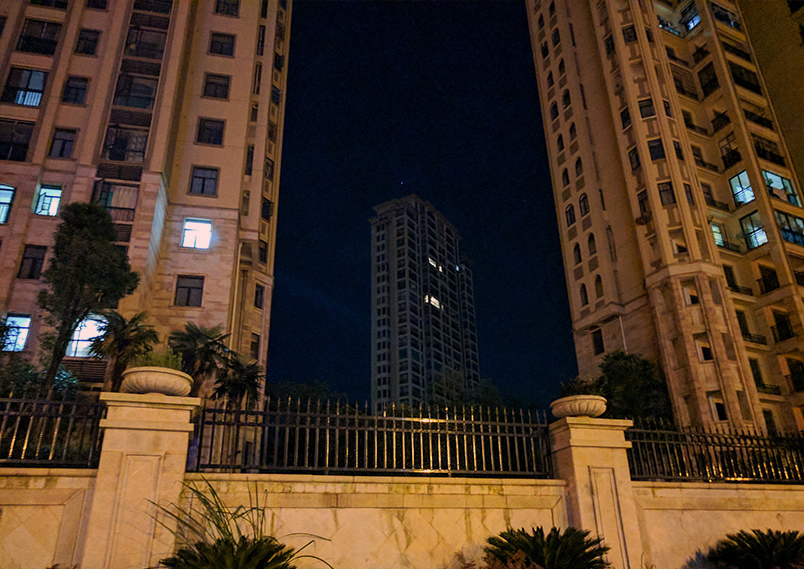 Highrise buildings in Ji'an, especially those built during the ongoing decade-long construction boom, generally have very low occupancy rates. The few lights on during the early evening in these apartments are a good indication of the occupancy rates.
Highrise buildings in Ji'an, especially those built during the ongoing decade-long construction boom, generally have very low occupancy rates. The few lights on during the early evening in these apartments are a good indication of the occupancy rates.
With so much new housing and commercial real estate lying empty throughout the city, and more on the way, a successful transit-oriented development (TOD) strategy in this context is about:
- Filling the developments adjacent to the planned BRT system
- Retrofitting the urban design of the BRT-adjacent developments, including ensuring excellent BRT station access
- Affecting new development, especially in BRT station area zones, though also including areas served by BRT routes.
These measures, along with the obstacles in the zoning codes to their adoption, are explored in more detail later in this series on TOD in Ji'an. This article provided some context for BRT and TOD planning as well as the current real estate situation in third-tier cities such as Ji’an. Later articles will focus on:
- Ji’an’s plans to build a BRT system, inspired by other recent successful BRT systems in Yichang and Guangzhou. China’s new investments in mass transit, both BRT and metro systems, give some hope that these investments, if coupled with changes in the zoning and planning regulations, might stimulate a new form of urbanism not dependent on private motor vehicle travel.
- The current planning and zoning regulations that affect land development in Ji’an, namely the planning and zoning guidelines for Jiangxi Province.
- A case study of an outstanding mixed-used urban development project in Ji'an called Ru Lin Li.
- Specific recommendations for how Ji’an might modify its planning and zoning regulations, and what it might do to enhance the chances of the new BRT system stimulating great transit-oriented developments along it.
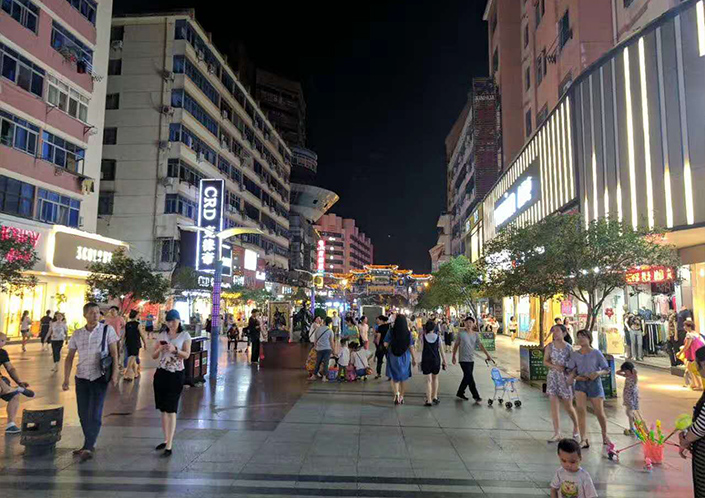
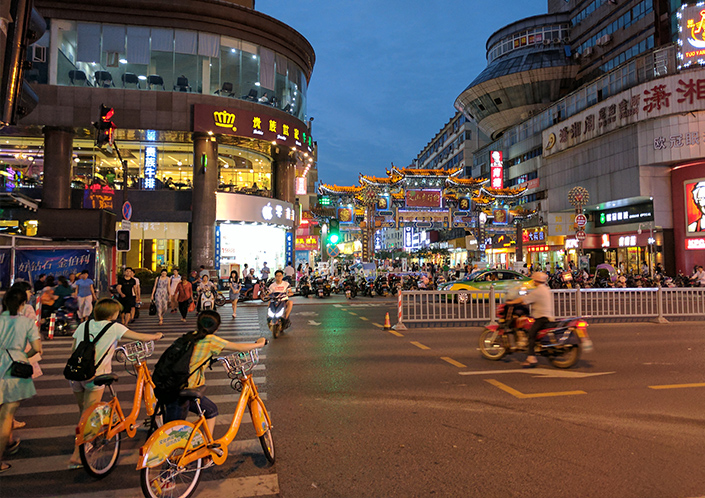
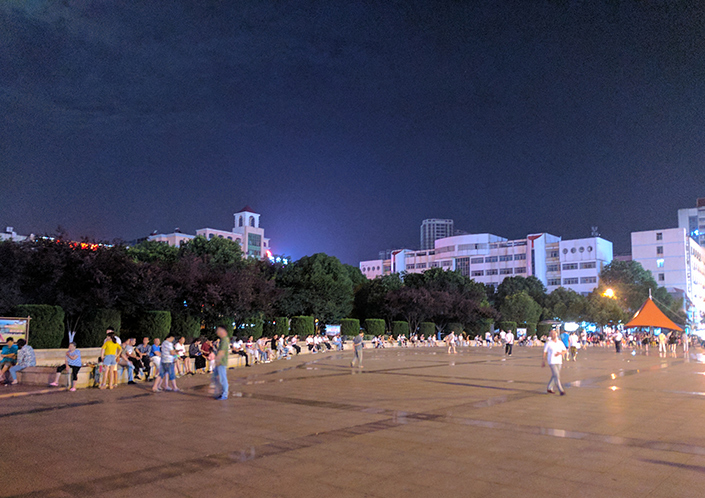 Ji'an has an excellent, extensive downtown pedestrian network, which is also where most of the public transport (and later BRT) demand is concentrated. The vibrant, mixed-use, pedestrian-oriented central area presents a stark contrast to many of the new development areas, though it is under threat from increasing motor vehicle parking encroachment and official neglect. The central area is the focus of proposed traffic management improvements including a parking zone proposal currently being developed.
Ji'an has an excellent, extensive downtown pedestrian network, which is also where most of the public transport (and later BRT) demand is concentrated. The vibrant, mixed-use, pedestrian-oriented central area presents a stark contrast to many of the new development areas, though it is under threat from increasing motor vehicle parking encroachment and official neglect. The central area is the focus of proposed traffic management improvements including a parking zone proposal currently being developed.
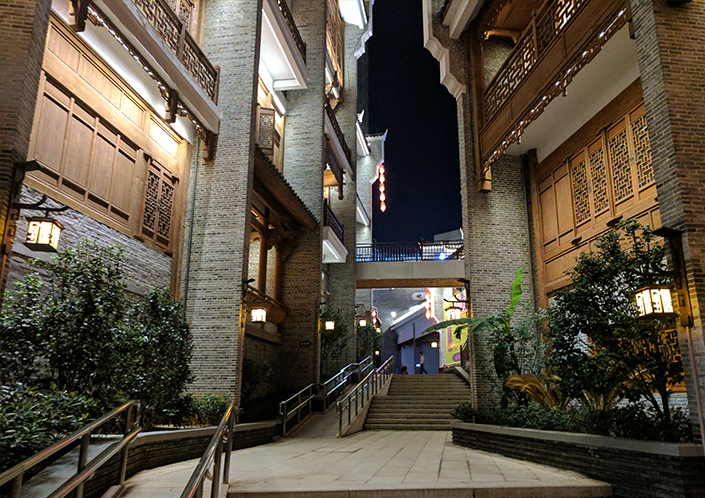
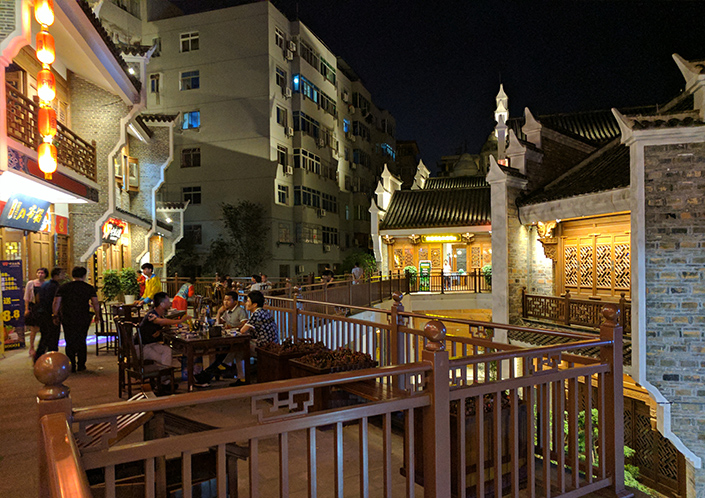
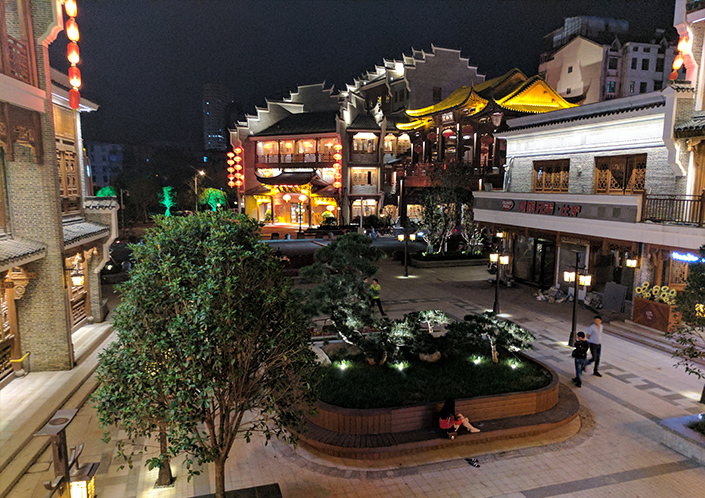 The world-class mixed-used Ru Lin Li development combines all the key TOD elements and is a 'gold standard' TOD development and model for Ji'an and other cities, though this development would not have been possible had the planning and building regulations been strictly followed.
The world-class mixed-used Ru Lin Li development combines all the key TOD elements and is a 'gold standard' TOD development and model for Ji'an and other cities, though this development would not have been possible had the planning and building regulations been strictly followed.
See the part 2 article on Ji'an TOD, which looks at issues of station area zoning, density, and mixed use.